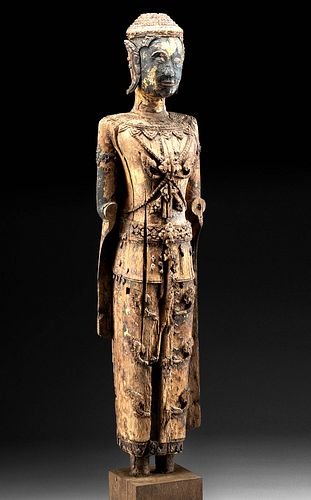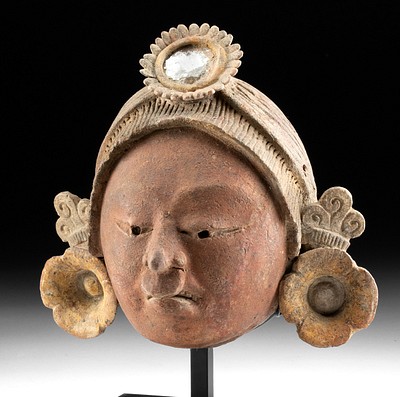Large 19th C. Thai Rattanakosin Gilt Wood Deity Figure
Lot 63
About Seller
Artemis Fine Arts
686 S Taylor Ave, Ste 106
Louisville, CO 80027
United States
Selling antiquities, ancient and ethnographic art online since 1993, Artemis Gallery specializes in Classical Antiquities (Egyptian, Greek, Roman, Near Eastern), Asian, Pre-Columbian, African / Tribal / Oceanographic art. Our extensive inventory includes pottery, stone, metal, wood, glass and textil...Read more
Categories
Estimate:
$8,000 - $12,000
Absentee vs Live bid
Two ways to bid:
- Leave a max absentee bid and the platform will bid on your behalf up to your maximum bid during the live auction.
- Bid live during the auction and your bids will be submitted real-time to the auctioneer.
Bid Increments
| Price | Bid Increment |
|---|---|
| $0 | $25 |
| $300 | $50 |
| $1,000 | $100 |
| $2,000 | $250 |
| $5,000 | $500 |
| $10,000 | $1,000 |
| $20,000 | $2,500 |
| $50,000 | $5,000 |
| $100,000 | $10,000 |
| $200,000 | $20,000 |
About Auction
By Artemis Fine Arts
Jul 14, 2022
Set Reminder
2022-07-14 10:00:00
2022-07-14 10:00:00
America/New_York
Bidsquare
Bidsquare : Exceptional Antiquities Ethnographica Fine Art
https://www.bidsquare.com/auctions/artemis-gallery/exceptional-antiquities-ethnographica-fine-art-9692
Museum-worthy examples of classical antiquities (Egyptian, Greek, Roman, Near Eastern), Viking, Far East / Asian, Pre-Columbian, African / Tribal, Oceanic, Native American, Spanish Colonial, Fossils, Ancient Jewelry, Fine / Visual Arts, so much more! Artemis Fine Arts info@artemisgallery.com
Museum-worthy examples of classical antiquities (Egyptian, Greek, Roman, Near Eastern), Viking, Far East / Asian, Pre-Columbian, African / Tribal, Oceanic, Native American, Spanish Colonial, Fossils, Ancient Jewelry, Fine / Visual Arts, so much more! Artemis Fine Arts info@artemisgallery.com
- Lot Description
Southeast Asia, Thailand, Rattanakosin Kingdom, ca. 19th century CE. meticulously carved wooden sculpture of a deity, likely a thepphanom or temple guardian, standing in a tranquil pose with liberal remains of lustrous gilding as well as black and red pigments. Showcasing a slender physique, the figure stands atop straight legs and wears a floor-length robe elaborately decorated with relief lotus flowers and abstract motifs. Layered necklaces lie across the broad shoulders, which taper to an elegantly long neck. Gazing downward, the figure presents a tranquil visage with dramatically arched brows, a flattened nose, and slender lips held in a warm smile. Curved ears with flared adornments flank the ovoid head, which is surmounted by a conical tiara comprised of tightly-packed nodules, while a long cape covers the verso. Size: 9.8" W x 38.5" H (24.9 cm x 97.8 cm); 46.5" H (118.1 cm) on included custom stand.
The Thepphanom came to earth when Buddha reached enlightenment, to serve as his protectors and later as guardians to temple and sacred texts, and their forms are based on Apsaras and Gandharvas - the devas who inhabit higher realms.
Provenance: private Hawaii, USA collection, 1995 to 2010; ex-M. Kobiashi collection, Hawaii, USA, acquired from 1960 to 2000
All items legal to buy/sell under U.S. Statute covering cultural patrimony Code 2600, CHAPTER 14, and are guaranteed to be as described or your money back.
A Certificate of Authenticity will accompany all winning bids.
PLEASE NOTE: Due to recent increases of shipments being seized by Australian & German customs (even for items with pre-UNESCO provenance), we will no longer ship most antiquities and ancient Chinese art to Australia & Germany. For categories of items that are acceptable to ship to Australia or Germany, please contact us directly or work with your local customs brokerage firm.
Display stands not described as included/custom in the item description are for photography purposes only and will not be included with the item upon shipping.
#172803Losses to feet, top of headdress, and forearms, as well as along stable fissures. Chips, nicks, and abrasions throughout, all commensurate with age. Otherwise, nicely preserved detail and liberal remains of gilding and pigments.Condition
- Shipping Info
-
All shipping is handled in-house for your convenience. Your invoice from Artemis Gallery will include shipping calculation instructions. If in doubt, please inquire BEFORE bidding for estimated shipping costs for individual items.
-
- Buyer's Premium



 EUR
EUR CAD
CAD AUD
AUD GBP
GBP MXN
MXN HKD
HKD CNY
CNY MYR
MYR SEK
SEK SGD
SGD CHF
CHF THB
THB














